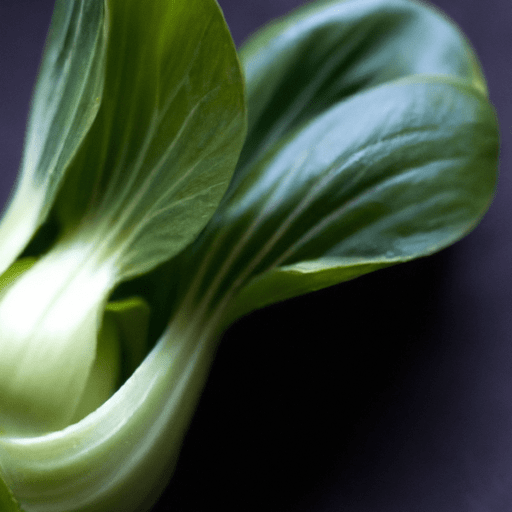The Versatile and Nutritious Pak Choi: A Delightful Addition to Your Kitchen
Pak choi, also known as bok choy or Chinese cabbage, is a leafy green vegetable that has gained popularity in kitchens around the world. With its mild flavor, crisp texture, and numerous health benefits, pak choi has become a staple ingredient in many Asian-inspired dishes. In this blog post, we will explore the culinary delights and nutritional value of pak choi, as well as some fascinating history and facts.
Taste and Texture
Pak choi possesses a delightful blend of flavors that makes it a versatile addition to your dishes. It offers a subtle, slightly sweet taste with a hint of bitterness, adding a refreshing note to stir-fries, salads, soups, and more. The leaves are tender and crisp, while the stems provide a satisfying crunch. When cooked, pak choi maintains its vibrant green color and retains a pleasant, juicy texture.
Cooking with Pak Choi
Thanks to its versatility, pak choi can be incorporated into numerous recipes. Here are some popular ways to enjoy this fantastic vegetable:
1. Stir-fries:
Pak choi is a common ingredient in stir-fried dishes. The tender leaves and crunchy stems are perfect for quick-cooking over high heat. Add pak choi towards the end of the stir-fry to retain its freshness and texture.
2. Soups and Noodle Dishes:
Enhance the flavor and nutritional profile of your soups and noodle dishes by adding pak choi. Its light, refreshing taste complements broths and adds a vibrant element to any bowl.
3. Salads and Slaws:
Whether you’re making a simple green salad or a zesty coleslaw, pak choi can be an excellent addition. Its crisp texture and mild flavor provide a pleasant contrast to other ingredients.
4. Steamed or Blanched:
Pak choi can also be steamed or blanched, resulting in a tender yet crunchy texture. Drizzle it with a little soy sauce, sesame oil, or oyster sauce for added flavor.
Nutritional Powerhouse
Pak choi is not only delicious but also highly nutritious. Packed with vitamins, minerals, and dietary fiber, it offers numerous health benefits, including:
Vitamin C: Pak choi is an excellent source of vitamin C, an essential antioxidant that supports immune function and collagen production.
Vitamin A: This leafy green is rich in vitamin A, promoting healthy vision, skin, and mucous membranes.
Vitamin K: Pak choi is a good source of vitamin K, which plays a crucial role in blood clotting and bone health.
Calcium: Despite its subtle taste, pak choi contains a significant amount of calcium, contributing to strong bones and teeth.
Iron: Pak choi is a valuable source of iron, an essential mineral involved in red blood cell production and oxygen transportation.
Low Calorie: With a mere 13 calories per 100 grams, pak choi is an excellent choice for those aiming to maintain a healthy weight.
Fascinating History and Facts
Here are some intriguing details about pak choi:
Origin: Pak choi originated in China, where it has been grown and consumed for centuries. It eventually spread to neighboring countries and gained popularity worldwide.
Chinese Symbolism: In Chinese culture, pak choi is a symbol of abundance, prosperity, and good fortune. It is often served during celebrations and festive occasions.
Various Names: This leafy green goes by different names, depending on the region. It is known as “bok choy” in Cantonese, “pak choi” in Mandarin, and “Chinese cabbage” in Western countries.
Different Varieties: Pak choi comes in various shapes and sizes, from baby pak choi, with tender leaves and petite stems, to mature pak choi, with larger leaves and thicker stems.
Easy to Grow: Whether you have a backyard garden or a small balcony, pak choi is relatively easy to grow. Its quick growing cycle makes it a popular choice for home gardeners.
Pak choi is a delightful and nutrient-packed vegetable that can elevate your cooking to new heights. With its mild flavor, versatility, and multiple health benefits, it’s no wonder pak choi has become a beloved ingredient in kitchens worldwide. So why not grab some pak choi on your next grocery run and discover the culinary wonders this leafy green has to offer?
Pak Choi
Origin: Pak choi, also known as bok choy or Chinese cabbage, is believed to have originated in China, where it has been cultivated for thousands of years. It is a staple in Chinese cuisine and is now grown and consumed in various parts of the world.
Common Uses: Pak choi is a versatile vegetable that can be used in a range of dishes. It can be stir-fried, steamed, sautéed, or added to soups and stews. It is commonly used in Asian cuisine, particularly in dishes like stir-fried noodles, dumplings, and hot pots.
Nutritional Benefits: Pak choi is a nutrient-rich vegetable. It is low in calories and high in dietary fiber. It is an excellent source of vitamin C, vitamin K, vitamin A, and several B vitamins. It also contains minerals such as calcium, iron, potassium, and magnesium.
Unique Properties: Pak choi has a distinct crunchy texture and mild flavor. The leaves and stalks have different textures, with the leaves being more tender and the stalks having a crispier bite. Both are edible and can be used in cooking. Pak choi is known for its quick cooking time, making it a popular choice for stir-fries and other quick meals.
Historical Significance: Pak choi has a long history in Chinese cuisine and has been an integral part of traditional Chinese cooking for centuries. It has also gained popularity in other parts of Asia and is now widely cultivated and consumed globally.




Use the share button below if you liked it.
It makes me smile, when I see it.